We have been using the mask for five months now. During this time the item has lost some of its strangeness, acquired some fashion quotient, bred much indignation and, while still breeding more, moved through levels of customisation. One thing is for sure in these times when nothing is — the mask cannot be cast aside any time soon.
The most common complaint about the mask is that it is suffocating. Some people cannot bear to wear a mask even for a few minutes, others have trouble wearing a mask and climbing stairs or walking long distances. Some get an itchy nose, a blotchy face. Others claim that even after taking off the mask, for the first few minutes there is an inexplicable discomfort.
All of this brings us to the question — is there such a thing as an overarching mask advice? Or would medical practitioners list out specific advice for specific sets? For instance, is there mask advice for toddlers who have started going to the creche once again? What about the teenaged boy with asthma who likes to take his bicycle out for a spin twice a day? Is there something the senior citizen with the heart condition should do while readying to head for the bank to withdraw his pension?
Broadly speaking, there are two types of masks. To the first category belongs the N95 that filters out 95 per cent of particles below 10 microns in size and the N99 that filters out 99 per cent of such particles. Then there are the three-ply or three-layered surgical masks and linen masks that often have one or two layers.
According to Dr Shantanu Nandy, a physician based in south Calcutta, any advisory related to masks should foreground the importance of “wearing a proper mask, properly”. Pulmonologist Dr Raja Dhar, a critical care specialist with Fortis, Calcutta, adds, “The challenge with the mask is that the more protection it provides an individual, the greater the discomfort associated with it.”
Dr Dhar explains the science behind the experienced breathing discomfort. He says, “When we breathe in and breathe out normally, we breathe in a very small amount of carbon dioxide. The N95 mask is airtight and when you have been wearing it for a period of time, you are potentially breathing in a slightly higher concentration of carbon dioxide. This might cause headaches, make you feel light-headed or even dizzy.”
He talks about mask users who have diseased lungs, perhaps someone with COPD (chronic obstructive pulmonary disease). He brings up the elderly whose lungs anyway function less optimally, whose airways are to an extent narrowed — maybe with smoking, maybe with pollution, maybe with exposure to biomass fuels. “For someone with a slightly reduced or a greatly reduced respiratory reserve, the impact of this carbon dioxide going in would be greater than in individuals who are so-called normal,” says Dr Dhar.
Because they are getting a little less oxygen and a little more carbon dioxide, people tend to breathe more rapidly. “If you breathe rapidly, the amount of oxygen and carbon dioxide going in might be higher but the effort of breathing rapidly through a mask might make you feel claustrophobic,” he cautions. The other side effects of breathing rapidly inside an airtight mask are dryness and dehydration.
The local pressure effects of the mask on the face also lead to erosion of the skin and itchiness.
According to Dr Nandy, to begin with, a normal person should use a three-ply surgical mask and wear it such that it covers the nose and mouth. He says, “N95 masks are meant for those who are in direct contact with Covid-19 or potentially positive Covid-19 patients. The N95 with a respirator affords protection to the user but is not safe for those around as the exhaled air goes out.”
To address the itchiness and skin irritation, Dr Dhar suggests keeping the face moist and clean. If you are wearing an N95 mask, you could shift it from time to time without compromising the fit. “You have to give yourself breaks; make sure you are in some place relatively secluded and take the mask off for brief periods of time,” he says and adds, “Make sure you are well hydrated when you are wearing masks for long — this is especially true of youngsters who are gymming, cycling and so on.” Dr Nandy’s advice is that gymming or vigorous exercise is better not done while wearing a mask.
Beyond these, both doctors agree, there are discomforts of the mind. There is anxiety about the virus that results in fear that in turn triggers panic reactions. Dr Nandy’s counsel is: “Using a mask in these times of pandemic is like using protective gear during a cricket match; it may be uncomfortable but it is life-saving. We have to mentally and physically prepare ourselves to wear a mask properly for the foreseeable future .”












